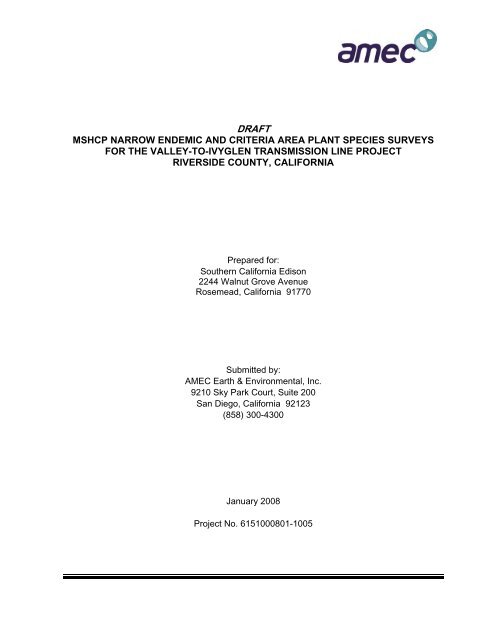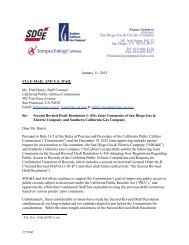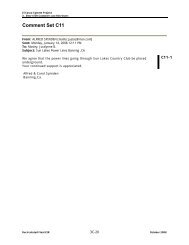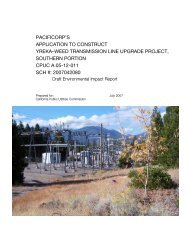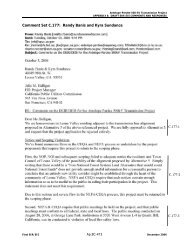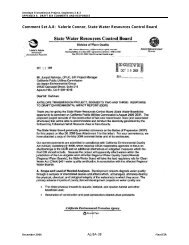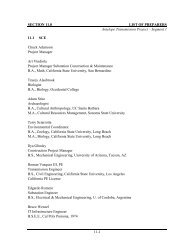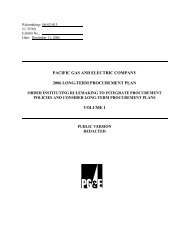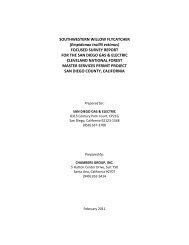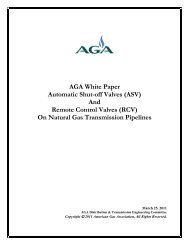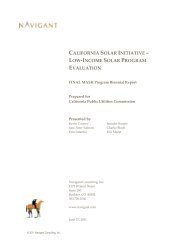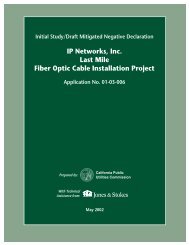draft mshcp narrow endemic and criteria area ... - State of California
draft mshcp narrow endemic and criteria area ... - State of California
draft mshcp narrow endemic and criteria area ... - State of California
You also want an ePaper? Increase the reach of your titles
YUMPU automatically turns print PDFs into web optimized ePapers that Google loves.
DRAFT<br />
MSHCP NARROW ENDEMIC AND CRITERIA AREA PLANT SPECIES SURVEYS<br />
FOR THE VALLEY-TO-IVYGLEN TRANSMISSION LINE PROJECT<br />
RIVERSIDE COUNTY, CALIFORNIA<br />
Prepared for:<br />
Southern <strong>California</strong> Edison<br />
2244 Walnut Grove Avenue<br />
Rosemead, <strong>California</strong> 91770<br />
Submitted by:<br />
AMEC Earth & Environmental, Inc.<br />
9210 Sky Park Court, Suite 200<br />
San Diego, <strong>California</strong> 92123<br />
(858) 300-4300<br />
January 2008<br />
Project No. 6151000801-1005
Southern <strong>California</strong> Edison<br />
Draft Valley-Ivyglen Transmission Project MSHCP Plant Surveys<br />
January 2008<br />
TABLE OF CONTENTS<br />
1.0 INTRODUCTION ...............................................................................................................1<br />
1.1 Project Background ...............................................................................................1<br />
2.0 METHODOLOGY..............................................................................................................9<br />
3.0 EXISTING BIOLOGICAL SETTING................................................................................11<br />
3.1 Climate.................................................................................................................11<br />
3.1.1 2006/2007 Rain Season ..........................................................................11<br />
3.2 Soils .................................................................................................................11<br />
3.3 Vegetation Communities......................................................................................13<br />
3.3.1 Coastal Sage Scrub.................................................................................13<br />
3.3.2 Grassl<strong>and</strong>s...............................................................................................14<br />
3.3.3 Agriculture................................................................................................15<br />
3.3.4 Developed or Disturbed L<strong>and</strong> ..................................................................15<br />
3.3.5 Woodl<strong>and</strong>s <strong>and</strong> Forest.............................................................................15<br />
3.3.6 Riversidean Alluvial Fan Sage Scrub ......................................................15<br />
3.3.7 Riparian Forest, Woodl<strong>and</strong>, <strong>and</strong> Scrub....................................................16<br />
3.3.8 Meadows <strong>and</strong> Marshes............................................................................16<br />
4.0 RESULTS........................................................................................................................17<br />
4.1 MSHCP Narrow Endemic <strong>and</strong> Criteria Area Plant Species .................................17<br />
5.0 RECOMMENDED ADDITIONAL ASSESSMENTS AND SURVEYS .............................20<br />
6.0 REFERENCES................................................................................................................21<br />
LIST OF FIGURES<br />
Figure 1. Project Vicinity .......................................................................................................2<br />
Figure 2. Narrow Endemic Species <strong>and</strong> Criteria Areas Species Survey Area......................4<br />
Figure 3. MSHCP Sensitive Soils .......................................................................................12<br />
Figure 4. Munz’s Onion <strong>and</strong> Small-Flowered Morning Glory ..............................................18<br />
Figure 5. Smooth Tarplant <strong>and</strong> San Diego Ambrosia .........................................................19<br />
LIST OF TABLES<br />
Table 1. MSHCP Narrow Endemic <strong>and</strong> Additional Criteria Area Species ...........................5<br />
Table 2. Survey Personnel <strong>and</strong> Dates ...............................................................................10<br />
Table 3. Preferred Route Vegetation Communities ...........................................................14<br />
LIST OF APPENDICES<br />
Appendix A Plant Species Encountered ............................................................................... A-1<br />
6151000801\R01-001_v2<br />
Page i
Southern <strong>California</strong> Edison<br />
Draft Valley-Ivyglen Transmission Project MSHCP Plant Surveys<br />
January 2008<br />
1.0 INTRODUCTION<br />
At the request <strong>of</strong> Southern <strong>California</strong> Edison (SCE), AMEC Earth & Environmental, Inc.<br />
(AMEC) conducted a special-status plant species survey for the proposed Valley-Ivyglen<br />
Transmission Line Project which is designed to improve reliability <strong>and</strong> meet projected<br />
electrical load requirements in the western Riverside County <strong>area</strong>.<br />
The proposed project is located in western Riverside County; the proposed transmission line<br />
route traverses unincorporated Riverside County, the cities <strong>of</strong> Lake Elsinore, Corona, Perris,<br />
<strong>and</strong> Sun City, <strong>California</strong> (Figure 1). The proposed transmission line route traverses portions<br />
<strong>of</strong> the following U.S. Geological Survey (USGS) 7.5-minute series topographic quadrangles:<br />
Alberhill, Lake Elsinore, <strong>and</strong> Romol<strong>and</strong>.<br />
The Valley-Ivyglen Transmission Line Project involves the construction <strong>of</strong> a new 115 kilovolt<br />
(kV) transmission line which will connect the Valley Substation to the Ivyglen Substation<br />
(Figure 1). The Valley Substation is located in the southwest corner <strong>of</strong> an unincorporated<br />
<strong>area</strong> known as Romol<strong>and</strong>, adjacent to the City <strong>of</strong> Perris. The Ivyglen Substation is located in<br />
the southeastern portion <strong>of</strong> unincorporated Corona, along Temescal Canyon Road <strong>and</strong> near<br />
Glen Ivy Hot Springs.<br />
1.1 Project Background<br />
The proposed Valley-Ivyglen Transmission Line Project is in the coverage <strong>area</strong> <strong>of</strong> the<br />
Western Riverside County Multiple Species Habitat Conservation Plan (MSHCP). The<br />
MSHCP is a comprehensive, multi-jurisdictional Habitat Conservation Plan (HCP) focusing<br />
on conservation <strong>of</strong> species <strong>and</strong> their associated habitats in western Riverside County.<br />
The MSHCP provides a conservation <strong>area</strong> for 146 special-status species, including federal-<br />
<strong>and</strong> state-listed endangered <strong>and</strong> threatened species, <strong>and</strong> provides incidental take permits for<br />
development projects that impact these conserved “covered” species. Under the MSHCP,<br />
the U.S. Fish <strong>and</strong> Wildlife Service (USFWS) <strong>and</strong> <strong>California</strong> Department <strong>of</strong> Fish <strong>and</strong> Game<br />
(CDFG) (collectively known as the “Wildlife Agencies”) will grant "Take Authorization" for<br />
otherwise lawful actions, such as public <strong>and</strong> private development that may incidentally take<br />
or harm individual species or their habitat outside <strong>of</strong> the MSHCP Conservation Area in<br />
exchange for the assembly <strong>and</strong> management <strong>of</strong> a coordinated MSHCP Conservation Area.<br />
Of the 146 species covered by the MSHCP, no surveys are required by applicants for public<br />
<strong>and</strong> private projects for 106 <strong>of</strong> these covered species. There are 14 <strong>narrow</strong> <strong>endemic</strong> plants<br />
<strong>and</strong> 13 other sensitive plants within the Criteria Area. Of these species, surveys will be<br />
required within suitable habitat <strong>area</strong>s in locations identified on MSHCP survey maps<br />
(Section 6.0 <strong>of</strong> the MSHCP) <strong>and</strong> avoidance <strong>and</strong> minimization measures implemented in<br />
accordance with the species-specific objectives for those species. The possibility exists that<br />
surveys may be avoided if the project is designed to avoid identified species <strong>and</strong> their<br />
associated habitats.<br />
6151000801\R01-001_v2<br />
Page 1
15<br />
Lake<br />
Elsinore<br />
15<br />
Canyon<br />
Lake<br />
Project Vicinity<br />
Plant Survey<br />
Valley - Ivyglen Transmission Line Project, <strong>California</strong><br />
215<br />
Perris<br />
Sun City<br />
215<br />
74<br />
215<br />
LEGEND<br />
Base Data<br />
Fresno<br />
Tulare<br />
Kern<br />
Ventura<br />
MAP NOTE<br />
Preferred Route<br />
(Updated on 08/16/2007)<br />
Survey Boundary<br />
Major Freeways<br />
Perennial Stream<br />
Intermittent Stream <strong>and</strong> Canal<br />
Parks <strong>and</strong> Forests<br />
Major Cities<br />
LOCATION MAP<br />
Inyo<br />
Nye<br />
San Bernardino<br />
<strong>California</strong><br />
Los<br />
Angeles<br />
Orange<br />
San<br />
Diego<br />
Data Source:<br />
AMEC - Project Boundary<br />
RCIP - Riverside MSHCP<br />
SCE - Proposed Segment, Base Data<br />
Projection: <strong>State</strong> Plane, <strong>California</strong> 406<br />
NAD 83, Feet<br />
Path: w\sd06\bio\SCE\ivy_glen\mxd\<br />
focus_survey\plant_survey\<br />
prj_vicinity.mxd<br />
Date: 01/14/2008<br />
PROTECTED MATERIALS - Contains Critical<br />
Energy Infrastructure Information.<br />
0 0.35 0.7 1.4 2.1 2.8 3.5<br />
Miles<br />
Riverside<br />
Nevada<br />
Clark<br />
Project<br />
Location<br />
Imperial<br />
Mohave<br />
F I G U R E<br />
1<br />
Arizona<br />
La<br />
Paz<br />
Yuma
Southern <strong>California</strong> Edison<br />
Draft Valley-Ivyglen Transmission Project MSHCP Plant Surveys<br />
January 2008<br />
The Valley-Ivyglen Transmission Line Project lies within identified MSHCP Narrow Endemic<br />
Plant Species Survey Areas (Figure 2). Within these <strong>area</strong>s, site-specific focused surveys for<br />
Narrow Endemic Plant Species (Table 1) is required for all public <strong>and</strong> private projects where<br />
appropriate habitat is present.<br />
In addition to the Narrow Endemic Plant Species, other surveys are needed for specific<br />
species “Criteria Area Species” (Table 1) in conjunction with the MSHCP. The Additional<br />
Survey Needs <strong>and</strong> Procedures policies presented in Section 6.3.2 <strong>of</strong> the MSHCP outlines<br />
these habitats <strong>and</strong> species. Additional surveys shall be conducted within suitable habitat for<br />
these species in the MSHCP Criteria Area (Figure 2).<br />
The proposed Valley-Ivyglen Transmission Line Project would also involve the construction<br />
<strong>of</strong> a new communication path, which would connect the Ivyglen Substation to the Valley<br />
Substation. This communication path is required for communication <strong>and</strong> monitoring <strong>of</strong> the<br />
substation <strong>and</strong> subtransmission line equipment. Along most <strong>of</strong> the telecommunication route,<br />
fiber optic cable will be installed overhead on the new Valley-Ivyglen 115 kV structures. The<br />
telecommunication line construction activities would begin subsequent to the construction <strong>of</strong><br />
the new Valley-Ivyglen 115 kV subtransmission lines. Some sections <strong>of</strong> the fiber optic line<br />
will be installed underground by the use <strong>of</strong> trenching <strong>and</strong>/or boring methods. The following<br />
sites where underground activities will occur were individually surveyed for sensitive species:<br />
a. Valley Substation – the trenched <strong>area</strong> includes approximately 500 feet from the<br />
substation fence to the Valley-Ivyglen Transmission Line riser pole (Map 1).<br />
b. Crossing at existing Elsinore-Ivyglen 115kV line <strong>and</strong> Lake Street – the trenched<br />
<strong>area</strong> includes approximately 500 feet beneath Lake Street (Map 29).<br />
c. Crossing I-15 at Hostettler Road – the trenched <strong>area</strong> includes approximately<br />
500 feet beneath the freeway along Hostettler Road (Map 31).<br />
d. Crossing Existing Elsinore-Ivyglen 115 kV line at Temescal Canyon Road – the<br />
trenched <strong>area</strong> includes approximately 500 feet at crossing beneath Temescal<br />
Canyon Road (Map 31).<br />
e. Ivyglen Substation – the trenched <strong>area</strong> includes approximately 1,500 feet along<br />
Temescal Canyon Road beneath the freeway, from Mayhew Road to the Ivyglen<br />
Substation (Map 23).<br />
6151000801\R01-001_v2<br />
Page 3
15<br />
Area 1: Brodiaea filifolia, Atriplex serenana var.davidsonii,<br />
Atriplex parishii, Centromadia pungens ssp laevis,<br />
Erodium macrophyllum, Lasthenia glabrata var. coulteri,<br />
Myosurus minimus<br />
AREA 2: Atriplex coronata var. natatior, Atriplex parishii,<br />
Atriplex serenana var. davidsonii, Brodiaea filifolia,<br />
Erodium macrophyllum, Centromadia pengens ssp. laevis,<br />
Lasthenia glabrata var. coulteri, Myosurus minimus<br />
AREA 3: Atriplex coronata var. natatior, Atriplex parishii,<br />
Atriplex serenana var. davidsonii, Brodiaea filifolia, Centromadia<br />
pungens ssp. laevis, Erodium macrophyllum, Lasthenia glabrata<br />
ssp. coulteri, Myosurus minimus, Nama stenocarpum<br />
AREA 4: Atriplex serenana var. davidsonii, Atriplex parishii,<br />
Brodiaea filifolia, Centromadia pungens ssp. laevis, Erodium<br />
macrophyllum, Lasthenia glabrata ssp. coulteri,<br />
Myosurus minimus<br />
AREA 8: Lepechinia cardiophylla<br />
AREA 9: Atriplex coronata var. natatior, Atriplex parishii,<br />
Atriplex serenana var. davidsonii, Brodiaea filifolia, Centromadia<br />
pungens ssp. laevis, Erodium macrophyllum, Lasthenia glabrata<br />
ssp. coulteri, Myosurus minimus, Nama stenocarpum<br />
74<br />
Narrow Endemic Species <strong>and</strong> Criteria Area Species Survey Area<br />
Valley - Ivyglen Transmission Line Project, <strong>California</strong><br />
15<br />
215<br />
215<br />
LEGEND<br />
Riverside MSHCP<br />
Project Data<br />
Base Data<br />
MSHCP Boundary<br />
Narrow Endemic Plant Species Survey<br />
Preferred Route<br />
(Updated on 08/16/2007)<br />
Survey Boundary<br />
Major Freeways<br />
Roads<br />
MAP NOTES<br />
Allium munzii, Ambrosia pumila,<br />
Dodecahema leptoceras, Dudleya multicaulis,<br />
Navarretia fossalis, Orcuttia californica,<br />
Satureja ch<strong>and</strong>leri, Sibaropsis hammittii,<br />
Trichocoronis wrightii var. wrightii<br />
Allium munzii, Ambrosia pumila,<br />
Dudleya multicaulis, Navarretia fossalis,<br />
Orcuttia californica, Sibaropsis Hammittii,<br />
Trichocoronis wrightii var wrightii<br />
Allium munzii, Ambrosia pumila,<br />
Dudleya multicaulis, Navarretia fossalis,<br />
Orcuttia californica,<br />
Trichocoronis wrightii var wrightii<br />
Allium munzii, Ambrosia pumila,<br />
Dudleya multicaulis, Navarretia fossalis,<br />
Orcuttia californica,<br />
Trichocoronis wrightii var. wrightii<br />
Dudleya multicaulis, Orcuttia californica,<br />
Navarretia fossalis, Satureja ch<strong>and</strong>leri,<br />
Sibaropsis hammittii,<br />
Trichocoronis wrightii var. wrightii<br />
Ambrosia pumila, Dudleya multicaulis,<br />
Navarretia fossalis, Orcuttia californica,<br />
Trichocoronis wrightii var wrightii<br />
Data Source:<br />
AMEC - Project Boundary<br />
RCIP - Riverside MSHCP<br />
SCE - Preferred Route, Base Data<br />
Projection: <strong>State</strong> Plane, <strong>California</strong> 406<br />
NAD 83, Feet<br />
Path: w\sd06\bio\SCE\ivy_glen\mxd\<br />
\focus_survey\Plant_survey<br />
\MSHCP_NESSA.mxd<br />
Date: 01/14/2008<br />
PROTECTED MATERIALS - Contains Critical<br />
Energy Infrastructure Information.<br />
0 0.5 1 2 3<br />
Miles<br />
F I G U R E<br />
2
Southern <strong>California</strong> Edison<br />
Draft Valley-Ivyglen Transmission Project MSHCP Plant Surveys<br />
January 2008<br />
Table 1. MSHCP Narrow Endemic <strong>and</strong> Additional Criteria Area Species<br />
Scientific Name Common Name Status Habitat/Elevation<br />
Allium marvinii Yucaipa Onion<br />
Allium munzii Munz's Onion<br />
Ambrosia pumila San Diego Ambrosia<br />
Arabis johnstonii<br />
Calochortus palmeri<br />
var. munzii<br />
Dodecahema leptoceras<br />
Dudleya multicaulis<br />
Galium angustifolium<br />
ssp. jacinticum<br />
Johnston's<br />
Rockcress<br />
Narrow Endemic Plant Species<br />
Munz's Mariposa lily<br />
Slender-Horned<br />
Spine Flower<br />
Many-Stemmed<br />
Dudleya<br />
San Jacinto<br />
Mountains Bedstraw<br />
List 1B.1<br />
CA-Endemic<br />
List 1B.1<br />
CA-Endemic<br />
ST 1/90<br />
FE 10/98<br />
List 1B.1<br />
FE 7/02<br />
List 1B.2<br />
CA-Endemic<br />
List 1B.2<br />
CA-Endemic<br />
List 1B.1<br />
CA-Endemic<br />
SE 1/82<br />
FE 9/87<br />
List 1B.2<br />
CA-Endemic<br />
List 1B.3<br />
CA-Endemic<br />
Chaparral (clay,<br />
openings)<br />
760 – 1,065 m<br />
Chaparral, Cismontane<br />
woodl<strong>and</strong>, Coastal scrub<br />
Pinyon <strong>and</strong> juniper<br />
woodl<strong>and</strong><br />
Valley <strong>and</strong> foothill<br />
grassl<strong>and</strong> /mesic, clay<br />
300 – 1,070 m<br />
Chaparral , Coastal scrub<br />
Valley <strong>and</strong> foothill<br />
grassl<strong>and</strong><br />
Vernal pools/<strong>of</strong>ten in<br />
disturbed <strong>area</strong>s,<br />
sometimes alkaline<br />
20 – 415 m<br />
Chaparral , Lower<br />
montane coniferous<br />
forest/<strong>of</strong>ten on eroded<br />
clay<br />
1350 – 2,150 m<br />
Chaparral , Lower<br />
montane coniferous<br />
forest<br />
1200 – 2,200 m<br />
Chaparral, Cismontane<br />
woodl<strong>and</strong>, Coastal scrub<br />
(alluvial fan)/s<strong>and</strong>y<br />
200 – 760 m<br />
Chaparral, Coastal<br />
Scrub, Valley & Foothill<br />
grassl<strong>and</strong>/<strong>of</strong>ten clay<br />
15 – 790 m<br />
Lower montane<br />
coniferous forest<br />
1,350 – 2,100 m<br />
Blooming<br />
Period<br />
Apr-May<br />
Mar-May<br />
Apr-Oct<br />
Feb-Jun<br />
Jun-Jul<br />
Apr-Jun<br />
Apr-Jul<br />
Jun-Aug<br />
6151000801\R01-001_v2<br />
Page 5
Southern <strong>California</strong> Edison<br />
Draft Valley-Ivyglen Transmission Project MSHCP Plant Surveys<br />
January 2008<br />
Table 1. MSHCP Narrow Endemic <strong>and</strong> Additional Criteria Area Species<br />
Scientific Name Common Name Status Habitat/Elevation<br />
Navarretia fossalis<br />
Orcuttia californica<br />
Spreading<br />
Navarretia<br />
<strong>California</strong> Orcutt<br />
Grass<br />
Phacelia stellaris Br<strong>and</strong>s Phacelia<br />
List 1B.1<br />
FE 10/98<br />
List 1B.1 SE<br />
9/79 FE 8/93<br />
List 1B.1<br />
FC<br />
Satureja ch<strong>and</strong>leri San Miguel Savory List 1B.2<br />
Sibaropsis hammittii<br />
Trichocoronis wrightii<br />
var. wrightii<br />
Atriplex coronata<br />
var. notatior<br />
Hammitt's Clay-<br />
Cress<br />
Wright's<br />
Trichocoronis<br />
San Jacinto Valley<br />
Crownscale<br />
List 1B.2<br />
List 2.1<br />
Criteria Area Species<br />
List 1B.2<br />
Atriplex parishii Parish's Brittlescale List 1B.1<br />
Atriplex serenana<br />
var. davidsonii<br />
Davidson's Saltscale List 1B.2<br />
Chenopod scrub,<br />
Marshes <strong>and</strong> swamps<br />
(assorted shallow<br />
freshwater), Playas,<br />
Vernal pools<br />
Vernal pools<br />
15 – 660 m<br />
Coastal dunes, Coastal<br />
scrub<br />
1 – 400 m<br />
Chaparral , Cismontane<br />
woodl<strong>and</strong>, Coastal scrub<br />
Riparian woodl<strong>and</strong>,<br />
Valley <strong>and</strong> foothill<br />
grassl<strong>and</strong>/rocky,<br />
gabbroic or metavolcanic<br />
120 – 1,075 m<br />
Chaparral(openings),<br />
Valley <strong>and</strong> foothill<br />
grassl<strong>and</strong>/clay<br />
720 – 1,065 m<br />
Meadows <strong>and</strong> seeps,<br />
Marshes <strong>and</strong> swamps,<br />
Riparian forest<br />
Vernal pools/alkaline<br />
5 – 435 m<br />
Coastal bluff scrub,<br />
Coastal dunes, Coastal<br />
scrub, Valley & Foothill<br />
grassl<strong>and</strong>/alkaline or clay<br />
3 – 460 m<br />
Chenopod scrub, Playas,<br />
Vernal pools<br />
25 – 1,900 m<br />
Coastal bluff scrub,<br />
Coastal scrub/alkaline<br />
10 – 200 m<br />
Blooming<br />
Period<br />
Apr-Jun<br />
Apr-Aug<br />
Mar-Jun<br />
Mar-Jul<br />
Mar-Apr<br />
May- Sep<br />
Mar-Oct<br />
Jun-Oct<br />
Apr-Oct<br />
6151000801\R01-001_v2<br />
Page 6
Southern <strong>California</strong> Edison<br />
Draft Valley-Ivyglen Transmission Project MSHCP Plant Surveys<br />
January 2008<br />
Table 1. MSHCP Narrow Endemic <strong>and</strong> Additional Criteria Area Species<br />
Scientific Name Common Name Status Habitat/Elevation<br />
Berberis nevinii Nevin's Barberry<br />
Brodiaea filifolia<br />
<strong>California</strong> macrophyllum<br />
Thread-Leaved<br />
Brodiaea<br />
Round-Leaved<br />
Filaree<br />
Ceanothus ophiochilus Vail Lake Ceanothus<br />
Centromadia pungens Smooth Tarplant<br />
Lasthenia glabrata<br />
ssp. coulteri<br />
Lepechinia cardiophylla<br />
List 1B.1<br />
CA-Endemic<br />
SE 01/87<br />
FE 10/13/98<br />
1B.1<br />
SE 01/82<br />
FT 10/13/98<br />
List 1B.1<br />
List 1B.1<br />
CA-Endemic<br />
SE 1/94<br />
FT 10/98<br />
List1B.1<br />
CA-Endemic<br />
Coulter's Goldfields List 1B.1<br />
Heart-Leaved<br />
Pitcher Sage<br />
List 1B.2<br />
Myosurus minimus Little Mousetail List 3.1<br />
Chaparral, Cismontane<br />
woodl<strong>and</strong>, Coastal scrub,<br />
Riparian scrub/s<strong>and</strong>y or<br />
gravelly<br />
295 – 825 m<br />
Chaparral, cismontane<br />
woodl<strong>and</strong>, coastal scrub,<br />
playas, Valley & Foothill<br />
25 – 860 m<br />
Cismontane woodl<strong>and</strong>,<br />
Valley & Foothill<br />
grassl<strong>and</strong>/clay<br />
15 – 1,200 m<br />
Chaparral(gabbroic or<br />
pyroxenite-rich outcrops)<br />
580 – 1,065 m<br />
Chenopod scrub,<br />
meadows, playas,<br />
riparian woodl<strong>and</strong>, Valley<br />
& Foothill grassl<strong>and</strong><br />
0 – 480 m<br />
Marshes <strong>and</strong><br />
swamps(coastal salt),<br />
Playas, Vernal pools<br />
1 – 1,220 m<br />
Closed-cone coniferous<br />
forest, Chaparral,<br />
Cismontane woodl<strong>and</strong><br />
520 – 1,370 m<br />
Valley <strong>and</strong> foothill<br />
grassl<strong>and</strong>, Vernal pools<br />
(alkaline)<br />
20 – 640 m<br />
Blooming<br />
Period<br />
Mar-Apr<br />
Mar-Jun<br />
Mar-May<br />
Feb-Mar<br />
Apr-Sept<br />
Feb-Jun<br />
Apr-Jun<br />
Mar-Jun<br />
6151000801\R01-001_v2<br />
Page 7
Southern <strong>California</strong> Edison<br />
Draft Valley-Ivyglen Transmission Project MSHCP Plant Surveys<br />
January 2008<br />
Table 1. MSHCP Narrow Endemic <strong>and</strong> Additional Criteria Area Species<br />
Scientific Name Common Name Status Habitat/Elevation<br />
Nama stenocarpum Mud Nama List 2.2<br />
Navarretia prostrata Prostrate Navarretia<br />
List 1B.1 CA-<br />
Endemic<br />
Marshes <strong>and</strong> swamps<br />
(lake margins,<br />
riverbanks)<br />
5 – 500 m<br />
Coastal scrub, Meadows<br />
<strong>and</strong> seeps, Valley <strong>and</strong><br />
foothill grassl<strong>and</strong><br />
(alkaline), Vernal<br />
pools/mesic<br />
125 – 700 m<br />
Blooming<br />
Period<br />
Jan-Jul<br />
Apr-Jul<br />
6151000801\R01-001_v2<br />
Page 8
Southern <strong>California</strong> Edison<br />
Draft Valley-Ivyglen Transmission Project MSHCP Plant Surveys<br />
January 2008<br />
2.0 METHODOLOGY<br />
Prior to field surveys, records from the CDFG <strong>California</strong> Natural Diversity Database (CNDDB)<br />
RareFind3 (CNDDB 2007) <strong>and</strong> the <strong>California</strong> Native Plant Society’s (CNPS) Inventory <strong>of</strong><br />
Rare <strong>and</strong> Endangered Plants (CNPS 2007) were reviewed for potential occurrence <strong>of</strong> any<br />
sensitive species or habitats within the quadrangles wherein the proposed Valley-Ivyglen<br />
Transmission Line Project lies. In addition, two previous studies conducted in association<br />
with the project, Draft Biological Resources Report Valley-Ivyglen Transmission Line Project<br />
Riverside County, <strong>California</strong> (Entrix, Inc. 2006) <strong>and</strong> Final Biological Technical Report for the<br />
Valley-Ivyglen Transmission Line Project Riverside County, <strong>California</strong> (AMEC 2006), were<br />
reviewed.<br />
Field maps were created prior to field visits (1 inch = 400 feet) which depicted the aerial view<br />
<strong>of</strong> the proposed transmission line route, known sensitive species points from CNDDB (2007)<br />
data <strong>and</strong> previous survey efforts (Entrix 2005 <strong>and</strong> AMEC 2006), <strong>and</strong> vegetation communities<br />
that were mapped during 2006 field surveys (AMEC 2006).<br />
Between 28 May <strong>and</strong> 5 June 2007, AMEC biologists conducted surveys for MSHCP Narrow<br />
Endemic <strong>and</strong> Criteria Area plant species within the preferred transmission line route.<br />
Surveyed <strong>area</strong>s included a 200-foot-wide corridor centered on the transmission line route.<br />
Botanical surveys were conducted following the CDFG Guidelines for Assessing the Effects<br />
<strong>of</strong> Proposed Project on Rare, Threatened, <strong>and</strong> Endangered Plants <strong>and</strong> Natural Communities<br />
(CDFG 2006) <strong>and</strong> the CNPS Botanical Survey Guidelines (CNPS 2001). Botanical surveys<br />
were performed when most plant species would be detectable. Areas with potential habitat for<br />
special-status species (i.e., mesic sites, rocky outcrops, clay or alkaline soils, etc.) were<br />
surveyed on foot. Other <strong>area</strong>s were surveyed by vehicle in <strong>area</strong>s where there was little to no<br />
potential for special-status species to occur or in highly disturbed <strong>area</strong>s. All plant species<br />
encountered during the field surveys were identified <strong>and</strong> recorded (Appendix A). Species<br />
that could not be identified immediately were brought into the laboratory for further<br />
investigation. Scientific <strong>and</strong> common names <strong>of</strong> plants follow The Jepson Manual (Hickman<br />
1993) or more recently published taxonomical revisions <strong>of</strong> genera.<br />
As part <strong>of</strong> the proposed project, a telecommunication route will also be installed along the<br />
proposed transmission line route. Areas where telecommunication construction activities will<br />
involve trenching <strong>and</strong>/or boring activities associated with the installation <strong>of</strong> the<br />
telecommunication line were also surveyed.<br />
Biological survey data was collected by numerous techniques including the use <strong>of</strong> a h<strong>and</strong>held<br />
Global Positioning System (GPS), st<strong>and</strong>ardized data forms, photographs, <strong>and</strong> aerial<br />
field maps. Surveys were conducted according to Table 2, which indicates survey dates.<br />
6151000801\R01-001_v2<br />
Page 9
Southern <strong>California</strong> Edison<br />
Draft Valley-Ivyglen Transmission Project MSHCP Plant Surveys<br />
January 2008<br />
Table 2. Survey Personnel <strong>and</strong> Dates<br />
Date Habitat Assessment<br />
2006<br />
April 24 <br />
April 25 <br />
April 26 <br />
April 27 <br />
May 02 <br />
May 03 <br />
May 04 <br />
Focused MSHCP<br />
Plant Surveys<br />
2007<br />
May 28 <br />
May 29 <br />
May 30 <br />
May 31 <br />
June 1 <br />
June 4 <br />
June 5 <br />
Surveyors:<br />
Matt Amalong; AMEC Biologist<br />
John F. Green; AMEC Botanist/Biologist<br />
Nathan Moorhatch; AMEC Biologist<br />
Patrick McConnell; AMEC Botanist<br />
6151000801\R01-001_v2<br />
Page 10
Southern <strong>California</strong> Edison<br />
Draft Valley-Ivyglen Transmission Project MSHCP Plant Surveys<br />
January 2008<br />
3.0 EXISTING BIOLOGICAL SETTING<br />
The topography in the study <strong>area</strong> is generally gentle rolling hills. The approximately 58 miles<br />
<strong>of</strong> study <strong>area</strong> contains a combination <strong>of</strong> agricultural, municipal, private, <strong>and</strong> reserve l<strong>and</strong>,<br />
most with previous disturbance.<br />
3.1 Climate<br />
The study <strong>area</strong> is located within a Mediterranean climate region consisting <strong>of</strong> warm, dry<br />
summers <strong>and</strong> mild, wet winters. In summer, temperatures <strong>of</strong>ten reach 100º F <strong>and</strong> winter<br />
temperatures fall into the 30s, with an occasional freeze. Average annual temperature<br />
ranges are fairly moderate for the <strong>area</strong>, ranging from 49.3º F to 79.5º F. Average total<br />
precipitation for the <strong>area</strong> is approximately 10 to 15 inches per year (Western Regional<br />
Climate Center 2005).<br />
3.1.1 2006/2007 Rain Season<br />
The 2006/2007 rain season (September 2006 through May 2007) was one <strong>of</strong> the driest<br />
winters on record for the Riverside region. The Elsinore station is the closest weather station<br />
to the project site with reliable monthly rainfall totals for the 2006/2007 rain season (i.e., no<br />
missing days during this period) (DRI 2007). The total rainfall for the 2006/2007 rain season<br />
to date was 0.44 inches (in) (1.11 centimeters [cm]), which falls extremely short <strong>of</strong> the yearly<br />
average (11.25 in [28.57 cm]) at this weather station by approximately 10.81 in (27.46 cm)<br />
(DRI 2007).<br />
3.2 Soils<br />
The project <strong>area</strong> is located on predominantly flat <strong>area</strong>s that have historically been used for<br />
grazing <strong>and</strong> agriculture. Soils in the study <strong>area</strong> are primarily in the Monserate-Arlington-<br />
Exeter <strong>and</strong> Traver-Domino-Willows associations. These soils are characterized as level to<br />
moderately steep soils that have a surface layer <strong>of</strong> s<strong>and</strong>y loam <strong>of</strong>ten with a hardpan. The<br />
soils can range from very shallow to relatively deep (USDA 1971). The soils in the <strong>area</strong> do<br />
not generally have a high clay component; however, there are “lenses” <strong>of</strong> clay soils in the<br />
study <strong>area</strong>.<br />
The Traver-Domino-Willows association is considered a MSHCP sensitive soil type <strong>and</strong><br />
includes saline-alkali soils largely located along floodplain <strong>area</strong>s <strong>of</strong> the San Jacinto River<br />
(Figure 3). Sensitive plants which may be supported by the Traver-Domino-Willows soil<br />
association include two federally listed species: San Jacinto Valley crownscale (Atriplex<br />
coronata var. notatior) <strong>and</strong> spreading navarretia (Navarretia fossalis). Other sensitive plant<br />
species found in this association include Parish's brittlescale (Atriplex parishii), Davidson's<br />
saltscale (Atriplex serenana var. davidsonii), <strong>and</strong> vernal barley (Hordeum intercedens)<br />
(County <strong>of</strong> Riverside 2003).<br />
6151000801\R01-001_v2<br />
Page 11
Indi<br />
ian<br />
Wash<br />
Temescal<br />
Wash<br />
74<br />
15<br />
MSHCP Sensitive Soils<br />
Valley - Ivyglen Transmission Line Project, <strong>California</strong><br />
Co ttttonwood Canyon Cr re ek<br />
San Jaci<br />
intto Ri ive rr<br />
215<br />
LEGEND<br />
MSHCP Sensitive Soil Groups<br />
Altamont clay<br />
Altamont cobbly clay<br />
Auld clay<br />
Project Data<br />
Base Data<br />
Auld cobbly clay<br />
Bosanko clay<br />
Porterville clay<br />
Porterville cobbly clay<br />
Porterville gravelly clay<br />
Traver fine s<strong>and</strong>y loam<br />
Traver loamy fine s<strong>and</strong><br />
Willows silty clay<br />
Rivers <strong>and</strong> Streams<br />
Perennial Stream<br />
Intermittent Stream<br />
Lake<br />
Road Classification<br />
Major Freeways<br />
Roads<br />
MAP NOTE<br />
Preferred Route<br />
(Updated on 08/16/2007)<br />
Survey Boundary<br />
Data Source:<br />
AMEC - Survey Boundary<br />
RCIP - Riverside MSHCP<br />
SCE - Preferred Route, Base Data<br />
Projection: <strong>State</strong>plane, <strong>California</strong> 406<br />
NAD 83, Feet<br />
Path: w\sd06\bio\SCE\ivy_glen\mxd\<br />
\focus_survey\plant_survey\soilmxd<br />
Date: 01/09/2008<br />
PROTECTED MATERIALS - Contains Critical<br />
Energy Infrastructure Information.<br />
0 0.5 1 2 3<br />
Miles<br />
F I G U R E<br />
3
Southern <strong>California</strong> Edison<br />
Draft Valley-Ivyglen Transmission Project MSHCP Plant Surveys<br />
January 2008<br />
Clay soils may support several listed threatened or endangered species: Munz's onion<br />
(Allium munzii), thread-leaved brodiaea (Brodiaea filifolia), <strong>and</strong> San Diego button celery<br />
(Eryngium aristulatum var. parishii). Other sensitive plant species occurring on clay soils<br />
include, Orcutt's brodiaea (Brodiaea orcuttii), long-spined spineflower (Chorizanthe<br />
polygonoides var. longispina), small-flowered morning glory (Convolvulus simulans), manystemmed<br />
dudleya (Dudleya multicaulis), Palmer's grapplinghook (Harpagonella palmeri),<br />
graceful tarplant (Holocarpha virgata ssp. elongata), <strong>and</strong> small-flowered microseris<br />
(Microseris douglasii ssp. platycarpha) (County <strong>of</strong> Riverside 2003).<br />
3.3 Vegetation Communities<br />
The vegetation communities <strong>and</strong> l<strong>and</strong> cover types in the Valley-Ivyglen Transmission Line<br />
Project <strong>area</strong> are primarily coastal sage scrub, grassl<strong>and</strong>s, agriculture, <strong>and</strong> developed<br />
disturbed l<strong>and</strong> (ruderal habitat). Additional plant communities found within the study <strong>area</strong><br />
include oak woodl<strong>and</strong>s, Riversidean alluvial fan sage scrub, riparian scrub/woodl<strong>and</strong>/forest,<br />
<strong>and</strong> wetl<strong>and</strong>s (Table 3). Previous agriculture, grazing, fire suppression, <strong>and</strong> invasion <strong>of</strong><br />
nonnative plant species have contributed to the disturbed condition <strong>of</strong> many vegetation<br />
communities in the study <strong>area</strong>.<br />
The vegetation communities which were identified in the Valley-Ivyglen Transmission Line<br />
Project <strong>area</strong> are described below. These communities are classified using the plant<br />
community definitions in the Western Riverside County MSHCP which is based on the<br />
vegetation communities presented in the Preliminary Descriptions <strong>of</strong> Terrestrial Natural<br />
Communities <strong>of</strong> <strong>California</strong> (Holl<strong>and</strong> 1986).<br />
3.3.1 Coastal Sage Scrub<br />
In western Riverside County, coastal sage scrub is found both in large contiguous blocks<br />
scattered throughout the county as well as integrated with chaparral <strong>and</strong> grassl<strong>and</strong>s. Coastal<br />
sage scrub is dominated by a characteristic suite <strong>of</strong> low-statured, aromatic, droughtdeciduous<br />
shrubs, <strong>and</strong> subshrub species. Composition varies substantially depending on<br />
physical circumstances <strong>and</strong> the successional status <strong>of</strong> the vegetation community; however,<br />
characteristic species include <strong>California</strong> sagebrush (Artemisia californica), <strong>California</strong><br />
buckwheat (Eriogonum fasciculatum), laurel sumac (Malosma laurina), <strong>California</strong> encelia<br />
(Encelia californica), <strong>and</strong> several species <strong>of</strong> sage (e.g., Salvia mellifera, S. apiana). Other<br />
common species include brittlebush (Encelia farinosa), lemonadeberry (Rhus integrifolia),<br />
sugarbush (R. ovata), yellow bush penstemon (Keckiella antirrhinoides), Mexican elderberry<br />
(Sambucus mexicana), sweetbush (Bebbia juncea), boxthorn (Lycium spp.), shore cactus<br />
(Opuntia littoralis), coastal cholla (O. prolifera), tall prickly-pear (O. oricola), <strong>and</strong> species <strong>of</strong><br />
Dudleya (Dudleya spp).<br />
A subcategory <strong>of</strong> this vegetation type includes Riversidean sage scrub. This habitat type is<br />
the most xeric expression <strong>of</strong> the coastal sage scrub habitat. It includes the species listed<br />
above; however, it occurs in much drier conditions.<br />
6151000801\R01-001_v2<br />
Page 13
Southern <strong>California</strong> Edison<br />
Draft Valley-Ivyglen Transmission Project MSHCP Plant Surveys<br />
January 2008<br />
Coastal Sage Scrub<br />
Table 3. Preferred Route Vegetation Communities<br />
Vegetation Community Acreage<br />
Undisturbed 123.24<br />
Disturbed 666.58<br />
Agriculture 15.87<br />
Agriculture Field Crop 8.81<br />
Agriculture Grove/Orchard 1.52<br />
Disturbed/Developed 1703.78<br />
Nonnative Grassl<strong>and</strong><br />
Undisturbed 743.09<br />
Disturbed 38.10<br />
Coast Live Oak Woodl<strong>and</strong> 12.10<br />
Riversidean Alluvial Sage Scrub<br />
Undisturbed 30.09<br />
Disturbed 2.00<br />
Alkali Marsh 22.75<br />
Open Water 6.76<br />
Seasonal Wetl<strong>and</strong> 0.56<br />
Riparian Scrub, Woodl<strong>and</strong>, Forest<br />
3.3.2 Grassl<strong>and</strong>s<br />
Southern Cottonwood/Willow Riparian Forest 57.12<br />
Southern Sycamore/Alder Riparian Woodl<strong>and</strong> 4.82<br />
Southern Willow Scrub 55.83<br />
Mule Fat Scrub 12.06<br />
Riparian Scrub 1.31<br />
Tamarisk Scrub 0.77<br />
Two general types <strong>of</strong> grassl<strong>and</strong>s occur in western Riverside County: (1) nonnative<br />
dominated, primarily annual grassl<strong>and</strong> (nonnative grassl<strong>and</strong>); <strong>and</strong> (2) native dominated<br />
perennial grassl<strong>and</strong> (valley <strong>and</strong> foothill grassl<strong>and</strong>).<br />
Valley <strong>and</strong> foothill grassl<strong>and</strong>s typically contain the perennial bunch grasses purple<br />
needlegrass (Nassella pulchra) <strong>and</strong> foothill needlegrass (N. lepida). Lesser amounts <strong>of</strong> other<br />
native grasses, such as onion grass (Melica spp.), wild rye (Leymus spp.), muhly<br />
(Muhlenbergia spp.), <strong>and</strong> cane bluestem (Bothriochloa barbinodis), may also be present. In<br />
addition, nonnative grasses or forbs may be present to varying degrees. Native herbaceous<br />
plants commonly found within valley <strong>and</strong> foothill grassl<strong>and</strong>s include yellow fiddleneck<br />
(Amsinckia menziesii), common calyptridium (Calyptridium monardum), suncup (Camissonia<br />
spp.), Chinese houses (Collinsia heterophylla), <strong>California</strong> poppy (Eschscholzia californica),<br />
6151000801\R01-001_v2<br />
Page 14
Southern <strong>California</strong> Edison<br />
Draft Valley-Ivyglen Transmission Project MSHCP Plant Surveys<br />
January 2008<br />
tarweed (Hemizonia spp.), coast goldfields (Lasthenia californica), common tidy-tips (Layia<br />
platyglossa), lupine (Lupinus spp.), popcornflower (Plagiobothrys spp.), blue dicks<br />
(Dichelostemma capitata), muilla (Muilla spp.), blue-eyed grass (Sisyrinchium bellum), <strong>and</strong><br />
dudleya (Dudleya spp.) (County <strong>of</strong> Riverside 2003).<br />
Nonnative grassl<strong>and</strong>s are likely to be dominated by several species <strong>of</strong> grasses that have<br />
evolved to persist in concert with human agricultural practices: slender oat (Avena barbata),<br />
wild oat (Avena fatua), fox tail chess (Bromus madritensis), s<strong>of</strong>t chess (Bromus hordeaceus),<br />
ripgut grass (Bromus di<strong>and</strong>rus), barley (Hordeum spp.), rye grass (Lolium multiflorum),<br />
English ryegrass (Lolium perenne), rat-tail fescue (Vulpia myuros), <strong>and</strong> Mediterranean<br />
schismus (Schismus barbatus) (County <strong>of</strong> Riverside 2003).<br />
3.3.3 Agriculture<br />
Agricultural l<strong>and</strong>s within the MSHCP boundary include <strong>area</strong>s occupied by dairies <strong>and</strong><br />
livestock feed yards or <strong>area</strong>s that have been tilled for use as cropl<strong>and</strong>s or groves/orchards<br />
(County <strong>of</strong> Riverside 2003).<br />
3.3.4 Developed or Disturbed L<strong>and</strong><br />
Developed or disturbed l<strong>and</strong>s consist <strong>of</strong> <strong>area</strong>s that have been disced, cleared, or otherwise<br />
altered. Developed l<strong>and</strong>s may include roadways, existing buildings, <strong>and</strong> structures. Disturbed<br />
l<strong>and</strong>s may include ornamental plantings for l<strong>and</strong>scaping, escaped exotics, or ruderal<br />
vegetation dominated by nonnative, weedy species such as mustard (Brassica sp.), fennel<br />
(Foeniculum vulgare), tocalote (Centaurea melitensis), <strong>and</strong> Russian thistle (Salsola tragus)<br />
(County <strong>of</strong> Riverside 2003).<br />
3.3.5 Woodl<strong>and</strong>s <strong>and</strong> Forest<br />
Woodl<strong>and</strong> <strong>and</strong> forest vegetation communities in western Riverside County are dominated by<br />
Engelmann oak (Quercus engelmannii), coast live oak (Q. agrifolia), canyon live oak<br />
(Q. chrysolepis), interior live oak (Q. wislizenii), <strong>and</strong> black oak (Q. kelloggii) in the canopy,<br />
which may be continuous to intermittent or savannah-like. Four-needle pinyon (Pinus<br />
quadrifolia), single-leaf pinyon pine (Pinus monophylla), <strong>and</strong> <strong>California</strong> juniper (Juniperus<br />
californica) are the canopy species <strong>of</strong> peninsular juniper woodl<strong>and</strong> which most commonly<br />
occur in Southern <strong>California</strong>, forming a scattered canopy from 3 to 15 meters (m) tall (County<br />
<strong>of</strong> Riverside 2003).<br />
3.3.6 Riversidean Alluvial Fan Sage Scrub<br />
Riversidean alluvial fan sage scrub occurs throughout many drainages within western<br />
Riverside County. Riversidean alluvial fan sage scrub is a Mediterranean shrubl<strong>and</strong> type that<br />
occurs in washes <strong>and</strong> on gently sloping alluvial fans. Alluvial scrub is made up predominantly<br />
<strong>of</strong> drought-deciduous s<strong>of</strong>t-leaved shrubs, but with significant cover <strong>of</strong> larger perennial<br />
species typically found in chaparral. Scalebroom (Lepidospartum squamatum) generally is<br />
regarded as an indicator <strong>of</strong> Riversidean alluvial scrub. In addition to scalebroom, alluvial<br />
scrub typically is composed <strong>of</strong> white sage (Salvia apiana), redberry (Rhamnus crocea),<br />
6151000801\R01-001_v2<br />
Page 15
Southern <strong>California</strong> Edison<br />
Draft Valley-Ivyglen Transmission Project MSHCP Plant Surveys<br />
January 2008<br />
<strong>California</strong> buckwheat, Spanish bayonet (Yucca whipplei), <strong>California</strong> croton (Croton<br />
californicus), cholla (Opuntia spp.), tarragon (Artemisia dracunculus), yerba santa<br />
(Eriodictyon spp.), mule fat (Baccharis sarothroides), <strong>and</strong> mountain-mahogany (Cercocarpus<br />
betuloides). Annual species composition has not been studied but is probably similar to that<br />
found in understories <strong>of</strong> neighboring shrubl<strong>and</strong> vegetation. Two sensitive annual species,<br />
slender-horned spineflower (Dodecahema leptoceras) <strong>and</strong> Santa Ana River woollystar<br />
(Eriastrum densifolium ssp. sanctorum) are <strong>endemic</strong> to alluvial scrub vegetation in western<br />
Riverside County (County <strong>of</strong> Riverside 2003).<br />
3.3.7 Riparian Forest, Woodl<strong>and</strong>, <strong>and</strong> Scrub<br />
Riparian vegetation, including forest, woodl<strong>and</strong>, <strong>and</strong> scrub subtypes, is distributed in<br />
waterways <strong>and</strong> drainages throughout much <strong>of</strong> western Riverside County. Depending on<br />
community type, a riparian community may be dominated by any <strong>of</strong> several trees/shrubs,<br />
including box elder (Acer negundo), bigleaf maple (Acer macrophyllum), coast live oak, white<br />
alder (Alnus rhombifolia), sycamore (Platanus racemosa), Fremont’s cottonwood (Populus<br />
fremontii), <strong>California</strong> walnut, Mexican elderberry, wild grape (Vitis girdiana), giant reed<br />
(Arundo donax), mule fat (Baccharis salicifolia), tamarisk (Tamarix spp.), or any <strong>of</strong> several<br />
species <strong>of</strong> willow (Salix spp.). In addition, various understory herbs may be present, such as<br />
saltgrass (Distichlis spicata), wild cucumber (Marah macrocarpus), mugwort (Artemisia<br />
douglasiana), stinging nettle (Urtica dioica), <strong>and</strong> poison-oak (County <strong>of</strong> Riverside 2003).<br />
Subcategories <strong>of</strong> these habitat types within the project <strong>area</strong> include mule fat scrub, southern<br />
cottonwood/willow riparian, <strong>and</strong> southern sycamore/alder riparian woodl<strong>and</strong>.<br />
3.3.8 Meadows <strong>and</strong> Marshes<br />
Meadow <strong>and</strong> marsh vegetation communities occur in both flowing <strong>and</strong> still water. This<br />
vegetation community includes cattails (Typha spp.), bulrushes (Scirpus spp.), sedges<br />
(Carex spp.), spike rushes, flatsedges (Cyperus spp.), smartweed (Polygonum spp.),<br />
watercress (Rorippa spp.), yerba mansa (Anemopsis californica). It also contains perennial<br />
<strong>and</strong> biennial herbs (e.g., Oenothera spp., Polygonum spp., Lupinus spp., Potentilla spp., <strong>and</strong><br />
Sidalcea spp.) <strong>and</strong> grasses (e.g., Agrostis spp., Deschampsia spp., <strong>and</strong> Muhlenbergia spp.).<br />
Rooted aquatic plant species with floating stems <strong>and</strong> leaves, such as pennywort<br />
(Hydrocotyle spp.), water smartweed (Polygonum amphibium), pondweeds (Potamogeton<br />
spp.), <strong>and</strong> water-parsley (Oenanthe sarmentosa) may also be present (County <strong>of</strong> Riverside<br />
2003).<br />
6151000801\R01-001_v2<br />
Page 16
Southern <strong>California</strong> Edison<br />
Draft Valley-Ivyglen Transmission Project MSHCP Plant Surveys<br />
January 2008<br />
4.0 RESULTS<br />
4.1 MSHCP Narrow Endemic <strong>and</strong> Criteria Area Plant Species<br />
Two populations <strong>of</strong> Munz’s onion (Map 32), a MSHCP Narrow Endemic Plant Species, <strong>and</strong> a<br />
population <strong>of</strong> small-flowered morning glory (Convolvulus simulans), a MSHCP Covered<br />
Species were identified during surveys conducted in 2006 (AMEC 2006) in association with<br />
clay soils along this route (Figure 4). Both populations were revisited during 2007 surveys;<br />
the population <strong>of</strong> small-flowered morning glory was identified within this <strong>area</strong>; however,<br />
Munz’ onion was not identified. Entrix, Inc. (2006) additionally identified populations <strong>of</strong><br />
smooth tarplant <strong>and</strong> San Diego ambrosia along this route (Figure 5); however, these species<br />
were not identified during AMEC’s 2006 or 2007 field investigations. No additional MSHCP<br />
Narrow Endemic, Criteria Area or other special-status plant species were identified during<br />
the botanical surveys <strong>of</strong> this transmission line route.<br />
Small-flowered morning-glory is restricted to clay soils <strong>and</strong> serpentine seeps <strong>and</strong> ridges,<br />
occurring below elevations <strong>of</strong> 700 m in southern valley needlegrass grassl<strong>and</strong>, mixed native<br />
<strong>and</strong> nonnative grassl<strong>and</strong>s <strong>and</strong> open Riversidian sage scrub (County <strong>of</strong> Riverside 2003).<br />
Small-flowered morning glory is designated as a MSHCP Group 2 species because the<br />
species is known from several MSHCP Core Areas <strong>and</strong> is restricted to particular soils series<br />
within the MSHCP <strong>area</strong>. Although the species has a scattered distribution (Lake Mathews,<br />
Alberhill, Santa Rosa Plateau, Murrieta Hot Springs, Vail Lake, Lake Skinner, East Hemet),<br />
populations appear to be concentrated in the vicinity <strong>of</strong> Vail Lake (County <strong>of</strong> Riverside 2003).<br />
6151000801\R01-001_v2<br />
Page 17
RFS<br />
DCSS<br />
DCSS<br />
DDL<br />
<br />
<br />
<br />
RFS<br />
DDL<br />
CLOW<br />
DCSS<br />
CLOW<br />
MFS<br />
CSS<br />
<br />
<br />
NNG<br />
DCSS<br />
DCSS<br />
<br />
<br />
<br />
<br />
<br />
<br />
<br />
<br />
<br />
<br />
<br />
<br />
<br />
SCWR<br />
CLOW<br />
<br />
<br />
DCSS<br />
DDL<br />
NNG<br />
DCSS<br />
DCSS<br />
RFS<br />
<br />
Sensitive Species (AMEC)<br />
CNDDB Points<br />
(December 2007)<br />
<br />
<br />
<br />
Coast Live Oak Woodl<strong>and</strong><br />
Coastal Sage Scrub<br />
Disturbed Coastal Sage Scrub<br />
Mule Fat Scrub<br />
Non-native Grassl<strong>and</strong><br />
Disturbed Non-native Grassl<strong>and</strong><br />
Riversidean Alluvial Fan Sage Scrub<br />
Southern Cottonwood/Willow Riparian<br />
Residential/Urban/Exotic<br />
Preferred Route<br />
(Updated on 08/16/2007)<br />
Survey Boundary<br />
<br />
Major Freeways<br />
Roads<br />
Note:<br />
The small-flowered morning glory was identified<br />
in 2006 <strong>and</strong> 2007; the Munz’ onion only in 2006.<br />
<br />
<br />
<br />
<br />
Data Source:<br />
AMEC - Survey Boundary<br />
RCIP - Riverside MSHCP<br />
SCE - Preferred Route, Base Data<br />
Projection: <strong>State</strong>plane, <strong>California</strong> 406<br />
NAD 83, Feet<br />
Path: w\sd06\bio\SCE\ivy_glen\mxd\<br />
\focus_survey\plant_survey\plant_1.mxd<br />
Date: 01/14/2008<br />
PROTECTED MATERIALS - Contains Critical<br />
Energy Infrastructure Information.<br />
1 inch equals 400 feet<br />
0 200 400 800<br />
Feet<br />
F I G U R E<br />
4
NNG<br />
smooth tarplant<br />
San Diego ambrosia<br />
ENTRIX<br />
NNG<br />
long-spined<br />
spineflower<br />
NNG<br />
NNG<br />
NNG<br />
NNG<br />
CSS<br />
San Diego<br />
ambrosia<br />
NNG<br />
SWS DCSS<br />
AM<br />
San Jacinto<br />
Valley<br />
crownscale<br />
DDL<br />
SWS<br />
Coulter’s<br />
goldfields<br />
AM<br />
DDL<br />
AM<br />
15<br />
NNG<br />
FWM<br />
OW<br />
DCSS<br />
Smooth Tarplant <strong>and</strong> San Diego Ambrosia<br />
Valley - Ivyglen Transmission Line Project, <strong>California</strong><br />
SWS<br />
NNG<br />
DDL<br />
DDL<br />
15<br />
SCWR<br />
SWS<br />
DDL<br />
DCSS<br />
NNG<br />
LEGEND<br />
Sensitive Species (AMEC)<br />
cnddbpnt<br />
Vegetation Communities<br />
Project Data<br />
Base Data<br />
Alkali Marsh<br />
Coastal Sage Scrub<br />
Disturbed Coastal Sage Scrub<br />
Coastal <strong>and</strong> Valley Freshwater Marsh<br />
Non-native Grassl<strong>and</strong><br />
Open Water/Reservoir/Pond<br />
Southern Cottonwood/Willow Riparian<br />
Southern Willow Scrub<br />
Residential/Urban/Exotic<br />
Road Classification<br />
Major Freeways<br />
Roads<br />
MAP NOTE<br />
Preferred Route<br />
(Updated on 08/16/2007)<br />
Survey Boundary<br />
Loc al Contex t<br />
Sensitive<br />
Plant<br />
15<br />
Data Source:<br />
AMEC - Plant Species Surveyed<br />
SCE - Preferred Route, Base Data<br />
Projection: <strong>State</strong>plane, <strong>California</strong> 406<br />
NAD 83, Feet<br />
Path: w\sd06\bio\SCE\ivy_glen\mxd\<br />
\focus_survey\plant_survey\plant_2.mxd<br />
Date: 01/14/2008<br />
PROTECTED MATERIALS - Contains Critical<br />
Energy Infrastructure Information.<br />
1 inch equals 400 feet<br />
0 200 400 800<br />
Feet<br />
15<br />
F I G U R E<br />
5<br />
215
Southern <strong>California</strong> Edison<br />
Draft Valley-Ivyglen Transmission Project MSHCP Plant Surveys<br />
January 2008<br />
5.0 RECOMMENDED ADDITIONAL ASSESSMENTS AND SURVEYS<br />
Field surveys <strong>of</strong> the proposed Valley-Ivyglen Transmission Line Project were conducted<br />
during late spring <strong>of</strong> 2007 (May <strong>and</strong> June). Additional focused botanical surveys during the<br />
spring <strong>of</strong> 2008 are recommended due to the limited rainfall that was received within the<br />
2006/2007 rain season. These surveys would have to be properly timed to determine the<br />
presence or absence <strong>of</strong> these species with a monthly site visit beginning in March to<br />
determine optimal blooming period for peak vegetative analysis.<br />
6151000801\R01-001_v2<br />
Page 20
Southern <strong>California</strong> Edison<br />
Draft Valley-Ivyglen Transmission Project MSHCP Plant Surveys<br />
January 2008<br />
6.0 REFERENCES<br />
<strong>California</strong> Department <strong>of</strong> Fish <strong>and</strong> Game. 2005. <strong>California</strong> Natural Diversity Data Base,<br />
Rarefind 3 (CNDDB) (Version 3.0.5).<br />
<strong>California</strong> Native Plant Society (CNPS). 2001. Botanical Survey Guidelines. <strong>California</strong> Native<br />
Plant Society. Sacramento, CA.<br />
CNPS. 2007. Inventory <strong>of</strong> Rare <strong>and</strong> Endangered Plants <strong>of</strong> <strong>California</strong> (7th edition) online<br />
version 7-06a . Accessed at:<br />
http://cnps.web.aplus.net/cgi-bin/inv/inventory.cgi<br />
County <strong>of</strong> Riverside. 2003. Western Riverside County Multiple Species Conservation Plan<br />
(MSHCP). Volume I: The Plan. Accessed online at:<br />
http://www.rctlma.org/<strong>mshcp</strong>/index.html<br />
Entrix, Inc. 2006. Draft Biological Resources Report Valley-Ivyglen Transmission Line<br />
Project. Prepared for Southern <strong>California</strong> Edison.<br />
Hickman, J. C. 1993. The Jepson manual: higher plants <strong>of</strong> <strong>California</strong>. University <strong>of</strong><br />
<strong>California</strong> Press, Berkeley, <strong>California</strong>. 1400 pp.<br />
Holl<strong>and</strong>, R.F. 1986. Preliminary descriptions <strong>of</strong> the terrestrial natural communities <strong>of</strong><br />
<strong>California</strong>. <strong>State</strong> <strong>of</strong> <strong>California</strong>, The Resources Agency.<br />
United <strong>State</strong>s (U.S.) Department <strong>of</strong> Agriculture (USDA). 1971. Soil survey, Western<br />
Riverside Area <strong>California</strong>. Soil Conservation Service, Washington, D.C. November<br />
1971.<br />
6151000801\R01-001_v2<br />
Page 21
Southern <strong>California</strong> Edison<br />
Draft Valley-Ivyglen Transmission Project MSHCP Plant Surveys<br />
January 2008<br />
Appendix A<br />
Plant Species Encountered<br />
6151000801\R01-001_v2<br />
Page A-1
Southern <strong>California</strong> Edison<br />
Draft Valley-Ivyglen Transmission Project MSHCP Plant Surveys<br />
January 2008<br />
Appendix A<br />
Plant Species Encountered<br />
Family Scientific Name Common Name Native/Exotic<br />
Aizoaceae<br />
Fig-Marigold<br />
Amaranthaceae<br />
Amaranth<br />
Anacardiaceae<br />
Sumac<br />
Apiaceae (Umbelliferae)<br />
Carrot<br />
Mesembryanthemum nodiflorum Little Ice Plant N<br />
Sesuvium verrucosum Sea-Purslane E<br />
Amaranthus albus White Tumbleweed N<br />
Amaranthus blitoides Prostrate Amaranth N<br />
Malosma (Rhus) laurina Laurel Sumac N<br />
Rhus integrifolia Lemonadeberry N<br />
Rhus ovata Sugar Bush N<br />
Schinus molle Brazilian Pepper Tree E<br />
Toxicodendron diversilobum Poison Oak N<br />
Apiastrum angustifolium Mock Parsley N<br />
Daucus pusillus Wild Carrot N<br />
Lomatium utriculatum Bladder Parsnip N<br />
Asteraceae (Compositae)<br />
Sunflower<br />
Ambrosia acanthicarpa S<strong>and</strong> Bur N<br />
Ambrosia psilostachya Western Ragweed N<br />
Anthemis cotula Mayweed E<br />
Artemisia californica <strong>California</strong> Sagebrush N<br />
Artemisia douglasiana Douglas’ Mugwort N<br />
Artemisia dracunculus Tarragon N<br />
Baccharis salicifolia Mule Fat N<br />
Baccharis sarothroides Broom Baccharis N<br />
Bebbia juncea Sweetbrush N<br />
Centaurea melitensis Tocalote E<br />
Cnicus benedictus Blessed Thistle E<br />
Conyza canadensis Horseweed N<br />
Conyza coulteri s Fleabane E<br />
Cotula coronopifolia African Brass Buttons E<br />
6151000801\R01-001_v2<br />
Page A-2
Southern <strong>California</strong> Edison<br />
Draft Valley-Ivyglen Transmission Project MSHCP Plant Surveys<br />
January 2008<br />
Family Scientific Name Common Name Native/Exotic<br />
Boraginaceae<br />
Borage<br />
Encelia californica <strong>California</strong> Encelia N<br />
Encelia farinosa Brittlebush N<br />
Dein<strong>and</strong>ra (Hemizonia) fasciculata Fascicled Tarplant N<br />
Ericameria palmeri var. pachylepis Box Spring Goldenbush N<br />
Erigeron foliosus var. foliosus Leafy Daisy N<br />
Eriophyllum confertiflorum Flat-Topped Goldern Yarrow N<br />
Filago californica Fluffweed E<br />
Filago gallica Narrow Leaf Filago E<br />
Gnaphalium californicum <strong>California</strong> Everlasting N<br />
Gnaphalium luteo-album Everlasting E<br />
Gnaphalium palustre Lowl<strong>and</strong> Cudweed N<br />
Gutierrezia californica <strong>California</strong> Matchweed N<br />
Hedypnois cretica Hedypnois E<br />
Helianthus annuus Western Sunflower N<br />
Helianthus gracilentis Slender Sunflower N<br />
Heterotheca gr<strong>and</strong>iflora Telegraph Weed N<br />
Iva axillaris Poverty Weed N<br />
Lactuca serriola Prickly Lettuce E<br />
Lepidospartum squamatum Scale Broom N<br />
Lessingia filaginifolia San Diego S<strong>and</strong> Aster N<br />
Matricaria globifera Cattle Bush E<br />
Matricaria matricarioides Pineapple Weed E<br />
Osmadenia tenella Osmadenia N<br />
Picris echioides Bristly Ox-Tongue E<br />
Pluchea sericea Arrow Weed N<br />
Rafinesquia sp. Chickory N<br />
Senecio flaccidus Butterweed N<br />
Silybum marianum Milk Thistle E<br />
Sonchus asper Prickly Sow Thistle E<br />
Sonchus oleraceus Common Sow Thistle E<br />
Stephanomeria virgata San Diego Wreath Plant N<br />
Stylocline gnaphalioides Everlasting Nest Straw N<br />
Tetradymia comosa Cotton-Thorn N<br />
Uropappus lindelyi Silver Puffs N<br />
Xanthium strumarium Cocklebur N<br />
6151000801\R01-001_v2<br />
Page A-3
Southern <strong>California</strong> Edison<br />
Draft Valley-Ivyglen Transmission Project MSHCP Plant Surveys<br />
January 2008<br />
Family Scientific Name Common Name Native/Exotic<br />
Heliotropium curassavicum Salt Heliotrope N<br />
Pectocarya linearis Comb-Bur N<br />
Brassicaceae (Cruciferae)<br />
Mustard<br />
Cactaceae<br />
Cactus<br />
Caprifoliaceae<br />
Honeysuckle<br />
Caryophyllaceae<br />
Pink<br />
Chenopodiaceae<br />
Goosefoot<br />
Athysanus pusillus Dwarf Athysanus N<br />
Brassica geniculata Mediterranean Mustard E<br />
Brassica rapa Field Mustard E<br />
Capsella bursa-pastoris Shephard’s Purse E<br />
Hirschfeldia incana Short-Pod Mustard E<br />
Lepidium nitidum Peppergrass E<br />
Lepidium dictyotum var. dictyotum Peppergrass N<br />
Lepidium latifolium Broad-Leaved Peppergrass E<br />
Raphanus sativus Wild Radish E<br />
Rorippa nasturtium-aquaticum Watercress N<br />
Sisymbrium irio London Rocket E<br />
Cylindropuntia parryi Cholla N<br />
Opuntia ficus-indica Mission Prickly Pear E<br />
Opuntia littoralis Coastal Prickly Pair N<br />
Sambucus mexicana Blue Elderberry N<br />
Spergularia bocconii Boccone’s S<strong>and</strong>spurry E<br />
Spergularia rubra Ruby S<strong>and</strong> Spurry E<br />
Atriplex argentea Silverscale Saltbush N<br />
Atriplex rosea Tumbling Oracle E<br />
Atriplex semibaccata Australian Saltbush E<br />
Atriplex suberecta Peregrine Saltbush E<br />
Bassia hyssopifolia Fivehook E<br />
Chenopodium californicum <strong>California</strong> Pigweed N<br />
Chenopodium murale Nettle-Leaved Goosefoot E<br />
Chenopodium pumili Clammy Goosefoot E<br />
6151000801\R01-001_v2<br />
Page A-4
Southern <strong>California</strong> Edison<br />
Draft Valley-Ivyglen Transmission Project MSHCP Plant Surveys<br />
January 2008<br />
Family Scientific Name Common Name Native/Exotic<br />
Convolvulaceae<br />
Morning Glory<br />
Cuscutaceae<br />
Dodder<br />
Crassulaceae<br />
Stonecrop<br />
Cyperaceae<br />
Sedge<br />
Euphorbiaceae<br />
Spurge<br />
Salsola tragus Russian Thistle E<br />
Calystegia macrostegia Morning Glory N<br />
Convolvulus arvensis Field Bindweed E<br />
Convolvulus simulans Small-Flowered Bindweed<br />
N<br />
CNPS list<br />
4.2/MSHCP<br />
Cressa truxillensis Alkali Weed N<br />
Cuscuta californica <strong>California</strong> Dodder N<br />
Cuscuta salina Salt Marsh Dodder N<br />
Crassula connata S<strong>and</strong> Pygmyweed N<br />
Dudleya lanceolata Live-Forever N<br />
Dudleya pulverulenta Chalk Live-Forever N<br />
Carex sp. Sedge N<br />
Cyperus eragrostis Tall Flatsedge N<br />
Cyperus Bearded N<br />
Eleocharis macrostachya Common Spikerush N<br />
Scirpus acutus Hardstem Bulrush N<br />
Scirpus californicus <strong>California</strong> Bulrush N<br />
Croton californicus <strong>California</strong> Croton N<br />
Chamaesyce albomarginata Rattlesnake Weed N<br />
Chamaesyce polycarpa Ground Spurge N<br />
Eremocarpus setiger Doveweed N<br />
Ricinus communis Castor Bean E<br />
Stillingia linearifolia Linear-Leaf Stillingia N<br />
Fabaceae (Leguminosae)<br />
Pea<br />
Astragalus pomonensis Pomona Rattleweed N<br />
Lotus hamatus Small-Flowered Lotus N<br />
6151000801\R01-001_v2<br />
Page A-5
Southern <strong>California</strong> Edison<br />
Draft Valley-Ivyglen Transmission Project MSHCP Plant Surveys<br />
January 2008<br />
Family Scientific Name Common Name Native/Exotic<br />
Fagaceae<br />
Oak<br />
Frankeniaceae<br />
Frankenia<br />
Gentianaceae<br />
Gentian<br />
Geraniaceae<br />
Geranium<br />
Hydrophyllaceae<br />
Waterleaf<br />
Juncaceae<br />
Rush<br />
Lamiaceae (Labiatae)<br />
Mint<br />
Lotus purshianus Spanish Clover N<br />
Lotus salsuginosus Alkali Lotus N<br />
Lotus scoparius ssp. brevialatus Deerweed N<br />
Lotus strigosus Strigose Bird’s Foot Treifoil N<br />
Lupinus bicolor Miniature Lotus N<br />
Lupinus excubitus Grape Soda Lupine N<br />
Lupinus succulentus Collar Lupine N<br />
Medicago polymorpha Bur-Clover E<br />
Parkinsonia aculeata Mexican Palo Verde E<br />
Trifolium obtusiflorum Clammy Clover N<br />
Vicia benghalensis Purple Vetch E<br />
Quercus agrifolia var. agrifolia Coast Live Oak N<br />
Quercus berberidifolia Scrub Oak N<br />
Frankenia salina Alkali Heath N<br />
Centaurium venustum Canchalagua N<br />
Erodium botrys Long-Beak Filaree E<br />
Erodium cicutarium Red-Stem Filaree E<br />
Phacelia distans Wild Heliotrope N<br />
Phacelia minor <strong>California</strong> Bluebells N<br />
Phacelia ramosissima var. latifolia Branching Phacelia N<br />
Juncus bufonius Toad Rush N<br />
Juncus mexicanus Mexican Rush N<br />
Lamium ampexicaule Henbit E<br />
6151000801\R01-001_v2<br />
Page A-6
Southern <strong>California</strong> Edison<br />
Draft Valley-Ivyglen Transmission Project MSHCP Plant Surveys<br />
January 2008<br />
Family Scientific Name Common Name Native/Exotic<br />
Liliaceae<br />
Lily<br />
Lythraceae<br />
Loosestrife<br />
Malvaceae<br />
Mallow<br />
Onagraceae<br />
Evening Primrose<br />
Papaveraceae<br />
Poppy<br />
Plantaginaceae<br />
Plantain<br />
Platanaceae<br />
Plane Tree<br />
Poaceae (Gramineae)<br />
Grass<br />
Marrubium vulgare Horehound E<br />
Robinia sp. Black Locust E<br />
Salvia apiana Clevel<strong>and</strong> Sedg N<br />
Salvia mellifera Black Sage N<br />
Stachys ajugoides Hedge Nettle N<br />
Chlorogalum parviflorum Small Flower Soap Plant N<br />
Lythrum californicum <strong>California</strong> Loosestrife N<br />
Lythrum hyssopifolia Grass Poly E<br />
Malacothamnus fasciculatus Bush Mallow N<br />
Malva parviflora Cheeseweed E<br />
Malvella leprosa Alkali Mallow N<br />
Camissonia bistorta Southern Sun Cup N<br />
Camissonia californica False Mustard N<br />
Epilobium ciliatum Willow Herb N<br />
Eschscholzia californica <strong>California</strong> Poppy N<br />
Romneya coulteri Matilija Poppy N<br />
Plantago erecta <strong>California</strong> Plantain N<br />
Plantago lanceolata Narrow-Leaf Plantain E<br />
Plantago major Plantain E<br />
Platanus racemosa Western Sycamore N<br />
Arundo donax Giant Reed E<br />
6151000801\R01-001_v2<br />
Page A-7
Southern <strong>California</strong> Edison<br />
Draft Valley-Ivyglen Transmission Project MSHCP Plant Surveys<br />
January 2008<br />
Family Scientific Name Common Name Native/Exotic<br />
Polygonaceae<br />
Buckwheat<br />
Portulaceae<br />
Purslane<br />
Primulaceae<br />
Primrose<br />
Rosaceae<br />
Rose<br />
Salicaceae<br />
Willow<br />
Avena fatua Wild Oat E<br />
Bromus catharticus Rescue Grass E<br />
Bromus di<strong>and</strong>rus Ripgut Grass E<br />
Bromus hordeaceus S<strong>of</strong>t Chess E<br />
Bromus madritensis ssp. rubens Red Brome E<br />
Distichlis spicata Saltgrass N<br />
Elymus condensatus Giant Wild Rye N<br />
Hordeum marinum Mediterranean Barley E<br />
Lolium multiflorum Italian Ryegrass E<br />
Lolium perenne Perennial Ryegrass E<br />
Phalaris paradoxa Canary Grass E<br />
Polypogon monspeliensis Rabbitfoot Grass E<br />
Bromus Ripgut E<br />
Bromus Ripgut E<br />
Chorizanthe staticoides Turkish Rugging N<br />
Eriogonum elongatum Long-Stemmed Eriogonum N<br />
Eriogonum fasciculatum var.<br />
foliolosum<br />
Leafy Buckwheat N<br />
Eriogonum gracile Slender Buckwheat N<br />
Polygonum aviculare Prostrate Knotweed E<br />
Rumex crispus Curly Dock E<br />
Rumex salicifolius Willow-Leaved Dock N<br />
Anagallis arvensis Scarlet Pimpernel E<br />
Ceanothus crassifolius Hoaryleaf Ceanothus N<br />
Rhamnus crocea Red-Berry N<br />
Adenostoma fasciculatum Chamise N<br />
Salix gooddingii Goodding’s Willow N<br />
6151000801\R01-001_v2<br />
Page A-8
Southern <strong>California</strong> Edison<br />
Draft Valley-Ivyglen Transmission Project MSHCP Plant Surveys<br />
January 2008<br />
Family Scientific Name Common Name Native/Exotic<br />
Scrophulariaceae<br />
Figwort<br />
Selaginellaceae<br />
Spike Moss Fmily<br />
Simaroubaceae<br />
Quassia<br />
Solanaceae<br />
Nightshade Family<br />
Saururaceae<br />
Lizard-Tail<br />
Urticaceae<br />
Nettle<br />
Verbenaceae<br />
Vervain<br />
Keckiella antirrhinoides Chaparral Beard-Tongue N<br />
Mimulus brevipes Hillside Monkeyflower N<br />
Mimulus cardinalis Scarlet Monkeyflower N<br />
Mimulus guttatus Common-Monkey Flower N<br />
Selaginella bigelovii Bigelow’s Spikemoss N<br />
Ailanthus altissima Tree Of Heaven E<br />
Datura wrightii Jimson Weed N<br />
Nicotiana quadrivalvis Indian Tobacco E<br />
Solanum douglasii White Nightshade N<br />
Anemopsis californica Yerba Mansa N<br />
Urtica dioica Stinging Nettle N<br />
Verbena lasiostachys Weedy Verbena N<br />
6151000801\R01-001_v2<br />
Page A-9


